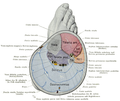Triceps surae muscle
This article needs additional citations for verification. (July 2018) |
| Triceps surae | |
|---|---|
plantarflexion | |
| Identifiers | |
| Latin | musculus triceps surae |
| TA98 | A04.7.02.043 |
| TA2 | 2656 |
| FMA | 51062 |
| Anatomical terms of muscle] | |
The triceps surae consists of two
Structure
The triceps surae is connected to the foot through the Achilles tendon, and has three heads deriving from the two major masses of muscle.[1]
- The superficial portion (the gastrocnemius) gives off two heads attaching to the base of the femur directly above the knee.
- The deep (profundus) mass of muscle (the soleus) forms the remaining head which attaches to the superior posterior area of the tibia.
The triceps surae is innervated by the tibial nerve, specifically, nerve roots L5–S2.
Function
Contraction of the triceps surae induce
Clinical significance
Calf strain (torn calf muscle)
A calf strain refers to damage to a muscle or its attaching tendons.[3][4] A premature return before recovery is achieved will result in a prolonged recovery or incomplete return to baseline prior to injury.[1] Stretches such as alternating calf raises can improve flexibility as well as mobilize legs before running.[4]
Calf muscles are a common place for fasciculations.
Additional images
-
Animation. Gastrocnemius and soleus are shown in different colors.
-
Illustration of thegastrocnemius.
-
Illustration ofsoleus.
-
Nerves, arteries and veins surround the gastrocnemius and soleus.
-
Cross section of the lower leg, with triceps surae at back (soleus and gastrocnemius)
-
Nerves and blood-vessels overlying the triceps surae
-
Photograph of thesoleusjunction.
Etymology and pronunciation
The term is pronounced /ˈtraɪsɛps ˈsjʊəri/. It is from Latin caput and sura meaning "three-headed [muscle] of the calf".
References
- ^ PMID 19468870.
- PMID 23341916.
- ^ "Calf Muscle Tear". physioworks.com.au. Retrieved 2020-02-09.
- ^ a b Minnor M (2018-05-03). "7 Pre- and Post-Workout Stretches for Runners – Aaptiv". Aaptiv. Retrieved 2018-06-11.
Further reading
- McCarthy JP, Hunter GR, Larson-Meyer DE, Bamman MM, Landers KA, Newcomer BR (August 2006). "Ethnic differences in triceps surae muscle-tendon complex and walking economy". Journal of Strength and Conditioning Research. 20 (3): 511–8. S2CID 23097795.




